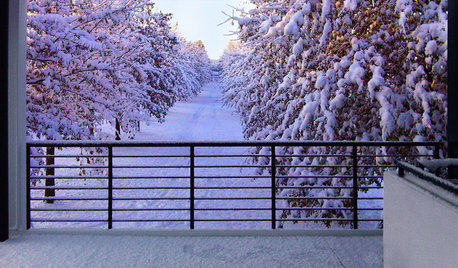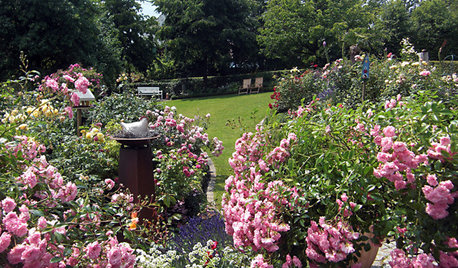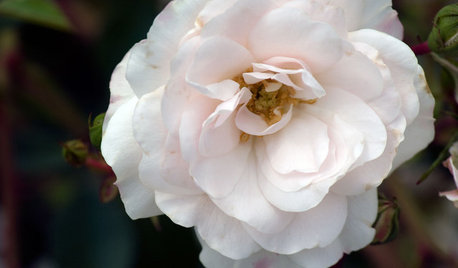A Review of 'Found' Roses
A REVIEW OF “FOUND” ROSES
By: Ronald Schwerdt
12-31-04
It may be in preparation for publishing of Modern Roses 11 in the near future, the American Rose Society (ARS) seen the light and noted, listing “found” roses are a waste. Taking up valuable space in the “Approved Exhibition Names for Exhibitor and Judges” (AEN) publication, which could be better utilized. With the removal of “found” roses, released premium space without increasing the size of future AEN publications. (A major cost savings concern for ARS).
New Guidelines written in September 2003 were released to the public earlier this year. Stating, ”found” roses must be listed in one of ARS recognized publication with an AEN, to be eligible for entry in ARS authorized shows. Modern Roses, ARS Handbook for Selecting Roses, Rose Registration column, and recent Registrations on the ARS website. In cases where a variety is not listed in any of the above publications, the Combined Rose List (CRL) primary name will be considered a temporary AEN, until listed in an ARS official publication.
The sole exception is “found” roses, which must be listed in an official (ARS publication) to be exhibited in classes for which ARS ribbons or certificates are awarded. Listed in the CRL is not sufficient for “found” roses. “Found” roses can be shown if the show has a special “found” rose class, than only for educational value. The March 2004 “Rose” magazine, further clarified this “found” rose rule to some extent, the guidelines exact meaning. Stating that “found” roses were removed from the 2004 AEN. That “found” roses could only be exhibited in classes carrying ARS awards if they are specifically listed in future ARS publications (2004 AEN), which makes it clear they can be exhibited in these classes.
The latest guidelines encourage show schedule writers, to include a special class for “found” roses lacking an official AEN. But in what ARS publication can these “found” roses be located? Only 31 are listed in MR XI, and according to the March statement in the “Rose”, MR XI or the 2002 AEN no longer can be used to verify, “found” roses status. Only the 2004 AEN publication can be used to identify “found “roses with an AEN, but it itself does not actually list all “found” roses per sec. The only source that consistently list and identify study names “SN” / “found” roses is the CRL publication, again as new guidelines indicate, “the CRL is not sufficient for “found” roses”. The 2004 CRL states “roses with the study names “SN” abbreviation are eligible to compete in special classes for “found” rose, where theses classes exist”. Not all “found” roses have an “SN” designation. Would ARS still consider this statement correct, as nothing has been mentioned about “SN” roses in the guidelines?
In a very carefully worded statement by ARS in the 2004 March “Rose” magazine, made reference to the 2004 AEN superseding (only all ARS publications) as a source of an AEN and (only for “found” roses). Was the intent of March’s “found” rose clarification article, also meant to override the sentence in the guidelines statement, “that the CRL is not sufficient for “found” roses” identification? They’re by allowing, “found” roses listed in the CRL, to be shown in these special classes of a show.
While many members of ARS are not that concerned about ARS judging documents, consensus judges and exhibitors are. When ARS stated the 2004 AEN supersedes all previous ARS publications and removed “found” roses from the AEN, makes a pretty powerful statement. And may have opened up a Pandora’s box, compounding to an existing unresolved issue. It could be said; clearer thinking may have given March’s “found” rose statement, greater thought of future repercussions prior to it being published.
Conventional wisdom would clearly indicate, prior to excluding all “found” roses from being exhibited except those listed in the 2004 AEN. ARS first publish a list of questionable roses and “found’ roses and state, these are roses that CANNOT be exhibited. That they can be shown if the show has a special class for “found” rose, than only for educational value. Sharing this information with ARS members. Unless such a list exists, it is virtually impossible for ARS members to verify and agree on roses to enter into these special “found” roses classes. Next consider deleting from the March “Rose” statement, reference to the 2004 AEN superseding all ARS publications as the only source of an AEN of “found” roses, and have removed “found” roses. ARS’s approach in regarding “found” roses removal, is putting the cart before the horse.
If individual interpretation of the March statement in the “Rose” magazine is correct, what ARS meant to imply, and said in no uncertain terms. Was that (all) “found” roses without an AEN have been removed from the 2004 AEN. Any rose (not) listed in this 2004 AEN prior to the end of February 2004), excluding new introductions, must be considerer a “found” rose. Roses appearing in this 2004 AEN (all) have AEN’s, and (all) roses having an AEN as to its publishing date, are included in this AEN. When the 2004 AEN is incorrect, or contains conflicting information than published in the CRL, the latest ARS publication is the final authority.
For a judge to actually believe and take serious all of the above is highly unlikely. Until ARS can publicly state an AEN publication is absolute at least to its published date, it cannot be considered the last word in judging. This raises several logical questions, if a rose listed in the 2004 AEN that technically is still considered a “found” rose, should it be disqualified? If a rose other than a “found” rose is listed in CRL, MR XI, handbooks, or other ARS publications prior to AEN’s 2004 publishing date, but is NOT listed in the 2004 AEN. Should judges consider this a “found” rose, which cannot be exhibited except in shows having a “found” rose class?
It may be appropriate as well as wise move, if ARS gave further thought and consider to temporary putting on hold, the “found” rose paragraph in the new guidelines until MR II is published. Giving ARS publications a period of adjustment. As far as I have seen, not many “found” roses are exhibited, or a critical judging issue. A bit of intelligent thinking at this time, could save further confusion and disagreement as to what rose is, or is not actually a “found” rose. As the majority of judges are well aware, new guidelines are going thru a transition period and in a state of confusion that may take many years to correct. Because the guidelines are in a big mess, ARS should avoid using the AEN as the scapegoat to correct the guidelines mistakes. The 2004 AEN has its own problems, and should concentrate on publishing an accurate 2005 AEN. Another reason for the “found” rose statement could be, ARS needed the room for new rose introductions and didn’t want to add additional pages to the AEN publication. (Typical to the ruckus ARS had in wanting to limit the number of pages, in the “Rose Exhibitor’s Forum” publication).
While the 2004 AEN supersedes all previous ARS publications and removed “found” roses may be ARS intent, it cannot be considered by any logical standard, an absolute judging publication and / or may ever be, simple by the nature of its present design. To date still lists 83 roses officially classified as “found” roses in previous CRL’s. Not included in the 2004 AEN published in March, are approximately 95 newer roses listed in the 2005 handbook published in September 2004, six months later. To fault the handbook for missing roses in the AEN would be wrong. For judges requiring early name verification of these new roses missing from the 2004 AEN, all 95 roses can be found in the 2004 CRL publication.
It is important to remember that the primary purpose of the handbook is NOT to assist judges or exhibitors, and ONLY includes roses in commerce in North America. There by missing 1000+ of new introductions listed in the CRL, NOT in commerce in North America. These roses will be published twelve months later in the 2005 AEN. There are sill new roses (not “found” roses) that are in the 2003 CRL, that have not been listed in the 2004 AEN. While the CRL is a non-ARS publication, ARS members must rely on it each year as the only official source for a complete listing of CRL new introductions that can be exhibited.
For ARS to achieve its ultimate goals of being the leader and have an absolute AEN publication, meeting the requirements of judges and exhibitors. ARS might consider moving its AEN publishing date a forward to April or May if necessary. Than transfer from the CRL, older and latest new rose introductions to the AEN. In this extra month or two, ARS would be able to pick-up the latest Rose Registrations off its web site, exceeding roses listed in the CRL. Without question, propel ARS in the right direction and one-step closer in becoming an absolute publication. Let me assure, you judges or exhibitors wouldn’t mind waiting an extra month, if in return received most of the latest rose information in an ARS publication a year earlier. Such a move on ARS part coupled with on-line AEN supplements and keeping the “Rose” registrations column updated, would be a very hard combination to beat. To be considered leader you have to lead, a great leader is one that also listens to his followers, never setting himself above his followers except in carrying out responsibilities.
Getting back to the issue of “found” roses. To fully understand “found” roses it may be necessary to regress to 1995, when the term “found” roses first appeared in the CRL and sanctioned by the ARS Judging Committee. As the original source of “found” roses stated, “It is important to realize, that a “found” rose is still an unidentified rose with a provisional name, even after being published in MR XI without outside quotation marks and no indication of it’s province”. (Province meaning, is serving for the time being, temporary).
What is a “found” rose? Prior to 1995, the CRL listed them as spurious or study names “SN” (as in the case of “found” roses). Webster’s dictionary defines “spurious” as illegitimate, similar, or having its own genuine qualities. ARS considers “found” roses, roses without any indication of their “found” status”. With most “found” roses, there is a question on actuality of existence, along with any documentary description on them provided in ARS publications. As a matter of fact, when past “found” roses were actually identified, most are identified as an existing rose with an AEN.
Why were “found” roses along with others roses of unknown sources, or documentary description published in MR XI? As ARS pointed out, approximately 8,000 roses were included for historical and botanical reasons as an experiment. Why, or what the exact nature of this unnecessary and unexplainable experiment was, still remains a mystery?
Where did these 8000 “found” roses come from? Unregistered roses in commerce listed in MR X, many OGR from Sangerhausen garden in Germany, Cavriglia in Italy, and catalogs from breeders / introducers from all over the world etc., most with little information of existence or documentary description. It should be noted; in other parts of the world, many roses are sold under synonyms to their official AEN’s. Compounding the problem is these same roses are sold in North America; the same rose but with a different name published in MR XI.
“Found” roses were transferred from CRL publications, to ARS handbooks from 1996 through 1999, and indicated as “found” roses. Of the 24,000+ roses listed in MR XI, only 31 carry a “found” rose designation. The only way a “found” rose can be identified in MR XI is if a variety actually states, “found” rose. In 2001 and 2002 AEN publications “found” roses were included, but never indicated as “found” roses. In the 2004 AEN they were eliminated. Other than the 31 roses that carry the “found” rose designation in MR XI, would ARS consider the remaining roses to still carry official AEN’s?
How did it come about, “found” roses were eligible to be exhibited? Prior to 1996, to exhibit a rose it was required to be registered. In 1995 the ARS board voted starting in 1996 to allow the showing of non-registered roses, including “found “roses. If a rose was listed in Modern Roses, The Handbook for Selecting Roses, Rose Registration column, and recent Registrations on the ARS website. If a rose was not listed in an ARS publication but listed in the CRL, it could be exhibited and considered to have a temporary AEN until listed in an ARS publication.
At present, approximately 1880+ temporary roses are listed in the 2004 CRL, which may not have appeared in any of ARS publication. According to the latest guidelines, this temporary rule is still valid. Will all roses designated as temporary, appear in the 2005 AEN publication with permanent AEN’s, or at some point in time phased out and simple referred to as “found” roses, or questionable roses? Even though none of the 1880+ roses were ever listed as “found” roses, in any CRL or ARS publication.
Why is it, “found” roses can no longer be exhibited and removed from the 2004 AEN? As previously stated, the new Guidelines and Rules for Judging Rose released to the public earlier this year. Stated, “found” roses must be listed in (official ARS publications) with an AEN. The CRL is not an ARS publication. As ARS explains the situation, “found” roses were removed from the 2004 AEN because these roses were transferred to MR XI from CRL publications without any indication of there (found status). In most cases “found” roses only include an AEN, classification and color. ARS decision of a “found” rose is based solely on the words (found status), the key word being status. As Webster dictionary defines the word status, “it is a thing in the eyes of the law”. Without an official ARS ruling or guideline that exists, actually giving specifics of what is a “found” rose, its conceivable that the term (found status) is actually open to individual interpretation.
Posted on this Garden Web site, is a partial listing of 855 roses published in MR XI, 195 were non-registered roses with only a few contain any information. Personal interpretation, consider them (questionable) “found” roses. All are listed in the 2004 AEN and lack any documentary information, similar to roses officially considerer “found” roses. There are also many 1000’s of other (questionable) “found” roses included in MR XI, that may also include a year and hybridizer or introducers name, will ARS eventually consider them (questionable) “found” roses? Depending on the criteria ARS considers, and uses in determining what is a “found” rose, is a major part of ARS’s problem. Realistically a rose with an AEN or a “found” rose, without any actual descriptive data is of little value to anyone, taking up space that ARS could utilized to list missing roses in future AEN’s.
With the 2004 AEN no longer publishing “found” roses without AEN’s, many roses listed in the 2004 AEN are still officially “found” roses. To be fair to all exhibitors, unless a judge is sure the following publications are available at a rose show. Technically he is required to carry MR XI, handbooks from 1996 through 1999 for “found” roses and 2000 to 2005 handbooks for missing roses from the 2004 AEN, the 2002 and 2004 AEN, recent Rose Registrations, ARS web site listings, and the CRL publications from 1995 to 2004, crosschecking one publication against the other, an extremely time consuming process. (Ridicules, and all because of little foresight on ARS “found” rose statement) Why these CRL publications? Typically, “found” roses are only listed in the CRL for three or four years, removed for various reasons and replaced with a fresh list of “found” roses, along with new rose introductions.
Modern Roses XI contains 24000+ roses but only 31 listed as “found” roses, along with many indescribable roses from other countries. It contains many thousands of roses with absolutely no documentary description, of (“found” status). Many are non-registered roses listed in MR X appendix, grandfathered into MR XI. Who can say what roses listed in MR XI, are actually “found” roses? (I believe that clarification by ARS, of what precisely is there definition of a “found” rose, would alleviate many of their problems). The term “found” rose, should also be included in the new guidelines glossary, being the basic term used in the guidelines defining roses that may or may not be exhibited.
At this point without serious research, I believe ARS does not actually know, or could publish a list of “found” roses and (questionable) “found” roses. Very possible after MR 11 is published, will such information become available. Should ARS decide against issuing a policy change, it would be expected ARS clarify their current position on judging issues, and address various questions raised in this article. This would be helpful and appreciated by ARS members. To quote in part of what Abraham Lincoln had said regarding “responsibility”, that ARS “can’t escape the responsibility of tomorrow by evading it today”.
















jimofshermanoaks
Related Professionals
Otsego Landscape Architects & Landscape Designers · Pacifica Landscape Contractors · Thornton Landscape Contractors · East Norriton Landscape Contractors · Hawaiian Gardens Landscape Contractors · Winchester Siding & Exteriors · Derry Siding & Exteriors · Adrian Decks, Patios & Outdoor Enclosures · Carmel Decks, Patios & Outdoor Enclosures · Conroe Decks, Patios & Outdoor Enclosures · Foothill Farms Decks, Patios & Outdoor Enclosures · Gaithersburg Decks, Patios & Outdoor Enclosures · Redmond Decks, Patios & Outdoor Enclosures · Richmond Decks, Patios & Outdoor Enclosures · Salisbury Decks, Patios & Outdoor Enclosures